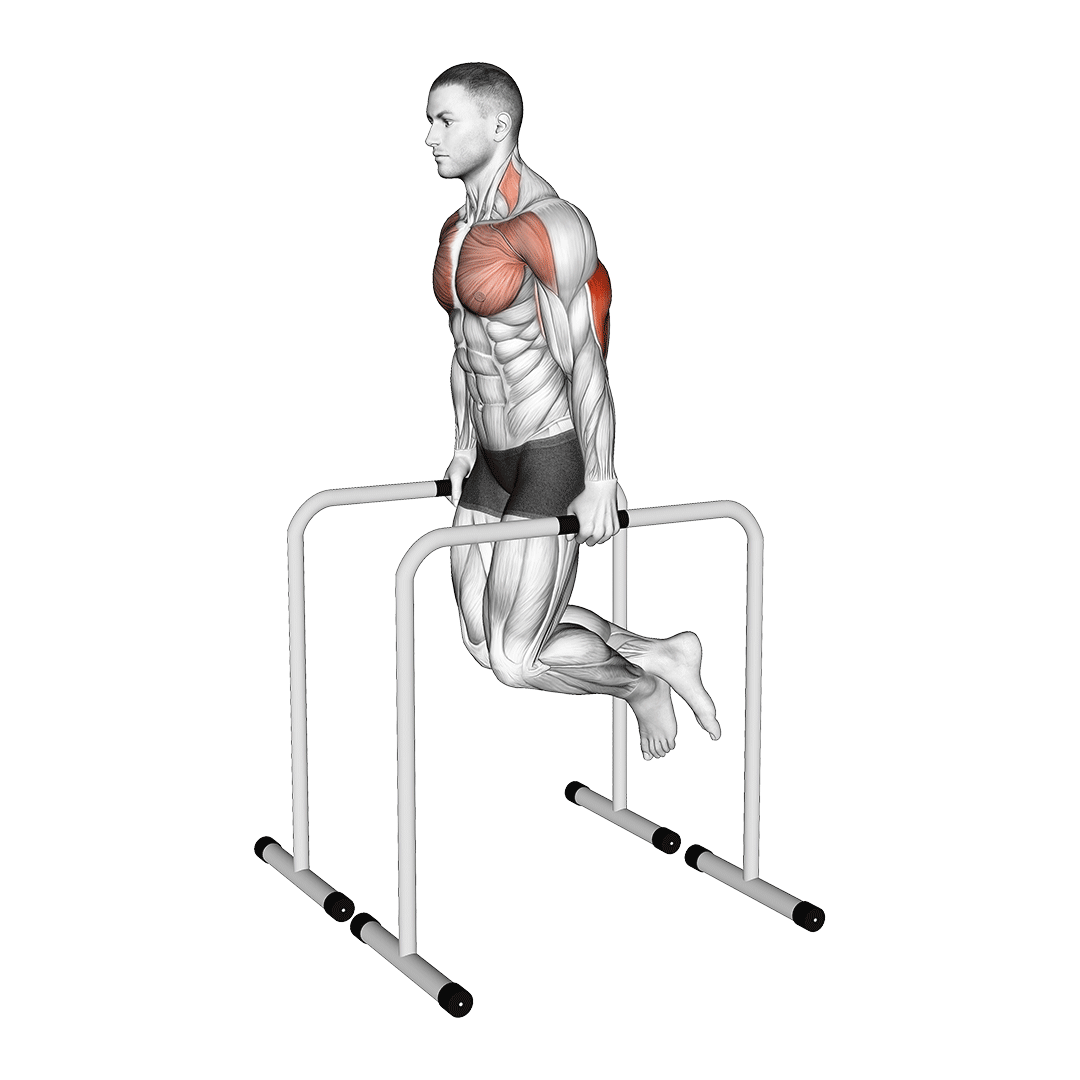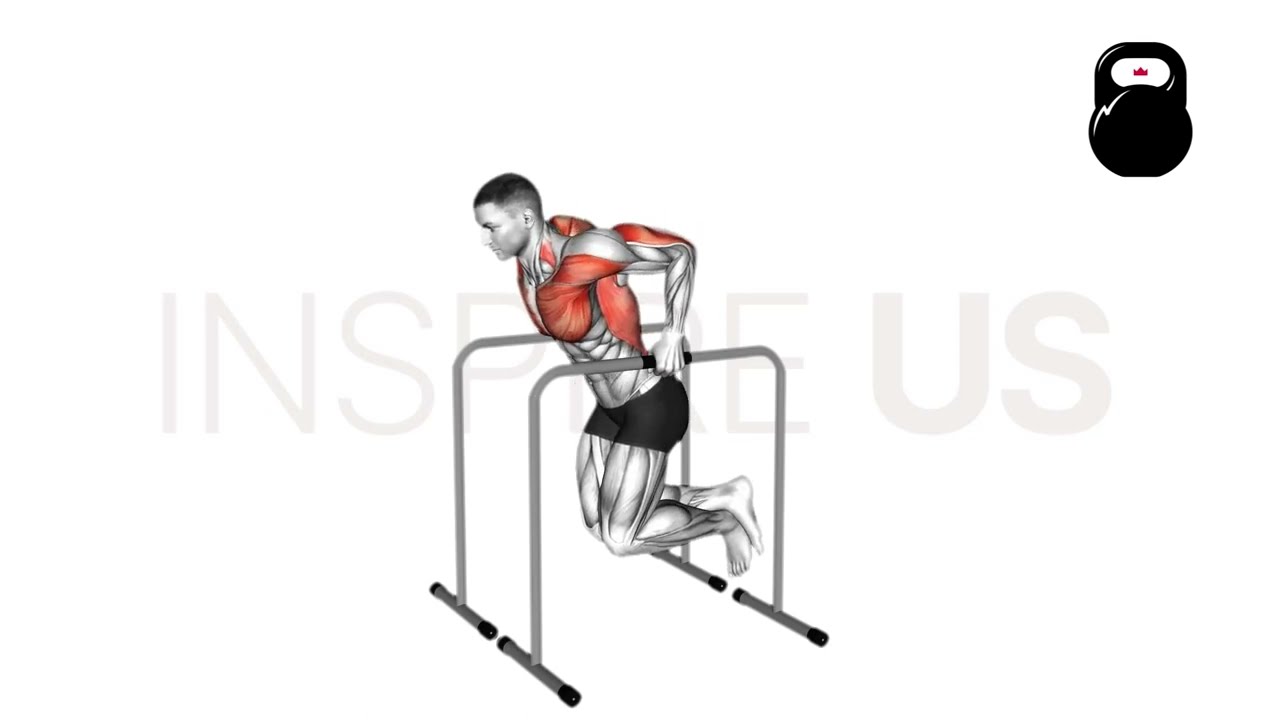Parallel Dips: Muscles Worked and More
Parallel bar dips (otherwise called chest dips) are a compound pushing exercise traditionally done with bodyweight resistance alone.
The movement is performed by having the lifter suspend themselves between a pair of parallel bars as they lower their chest between them, utilizing elbow flexion and extension to drive much of the force needed.
Parallel Dips at a Glance
Equipment Requirements
Parallel Bars, Dip Belt and Weights (Optional)
Main Muscles Targeted
Chest, Triceps Brachii, Shoulders
Difficulty
Moderate
Sets, Reps, and Load Recommendations
3-5 Sets of 8-12 Repetitions With Bodyweight Resistance (Unweighted)
2-4 Sets of 6-10 Repetitions With a Moderate Load
How to Do Parallel Dips
- To perform a repetition of parallel dips, the lifter will begin by first suspending themselves over the bars, hands neutral and feet held off the floor beneath the upper body.
The elbows should begin in a fully extended position, hands positioned beneath the shoulders with the trunk angled several degrees forwards for greater pectoral contraction.
The scapula should be partially retracted and depressed. Throughout the set, little to no scapular elevation should occur. - Now positioned correctly, the lifter bends at the elbows and lowers their trunk between the bars, leaning further forwards and keeping the core braced as they do so.
- Once the elbows are within a 90 degree angle of flexion, the lifter then presses through their palms and pushes their body back upwards. This should extend the elbows and reduce the trunk’s forward angle somewhat, ending with the lifter back in their original position.
- With the elbows fully extended once more, the repetition is considered to be complete.
Additional Tips:
If available, the lifter can adjust the placement and angle of the bars so as to better emphasize different push muscles.
Generally, wider bars angled inwards (towards the body’s midline when suspended above them) are ideal for working the chest. Of course, the opposite (narrow, angled outwards) is superior for targeting the triceps instead.
Another tip is to experiment with trunk angle for reduced shoulder strain and greater chest contraction. Though a somewhat forward lean is ideal for hitting the pecs, too far forwards can increase the risk of shoulder joint impingement.
What Muscles Do Parallel Bar Dips Work?
Parallel dips are a compound movement, meaning that they will work more than a single muscle group simultaneously.

These muscles are primarily the triceps brachii and pectoral muscles - both of which engage to create elbow extension and arm adduction, respectively.
However, alongside these two muscle groups is the anterior deltoid head, where it is activated to stabilize and maintain arm flexion at the shoulder joint as the lifter rises out of depth.
Common Parallel Dip Mistakes to Avoid
The following common parallel dip mistakes should be corrected if present in your training, as they will not only reduce the effectiveness of the exercise but also significantly increase your risk of injury.
Poor Range of Motion or an Excessively Rapid Tempo
Much like any other exercise, the parallel dip is rendered less effective when performed with an incomplete range of motion.

Even with actual training stimulus notwithstanding, poor ROM can increase strain on the elbow and shoulder joints, as well as lead to the development of issues like sticking points or instability.
Overall, lifters will want to ensure that each repetition begins and ends with the elbows fully extended and the trunk raised high over the parallel bars. Likewise, maximum depth should involve the elbows bent at a 90 degree angle.
In connection with a poor range of motion, lifters should also ensure that the entire repetition is performed in a slow and controlled manner so as to maximize hypertrophic response - especially during the latter eccentric phase.
Dipping Too Far Down
Though a full range of motion is indeed important, parallel dips should not be performed to a depth beyond a 90 degree angle of elbow flexion.
Doing so greatly increases strain within the shoulder and elbow joints, and can potentially lead to muscular injuries of the pectorals.
One good cue to follow is to align the upper arms horizontally parallel with the floor - though this will require craning the neck, and should only be done when still mastering proper form.
Completely Vertical Trunk Angle
The parallel bar dip is most effective (and safe) when performed with a 20-30 degree angle to the upper body.
Adopting an entirely vertical trunk orientation will greatly reduce the involvement of the chest muscles, and can lead to issues relating to the trapezius and the rotator cuff.
Lifters who find that they consistently descend with the trunk in a vertical angle may be trying to align their lower body incorrectly. Bending the knees slightly and allowing the feet to swing behind the hips can help create a more ideal trunk angle.
Elevating the Scapula/Hunching the Shoulders
Though schools of thought vary regarding scapula position and chest dips, the general consensus is that protraction and elevation of the scapula is more likely to increase strain on the shoulder joints.
Furthermore, allowing the scapula to engage in this manner can involve muscles like the trapezius and latissimus dorsi, drawing emphasis away from the intended mobilizer muscles.
At the start of each set, the lifter should ensure that their scapula is pulled downwards and partially retracted - preventing the shoulders from hunching upwards or rotating internally throughout each repetition.
Who Should Do Parallel Dips?
As a bodyweight exercise, parallel dips are suitable for most intermediate-level lifters with the upper body strength to perform them.
Those unfamiliar with proper form or who have yet to develop said strength can instead perform machine-assisted parallel dips - of which is the exact same exercise, only with less load involved.
Of course, because of the inherent strain placed on the elbow and shoulder joints by the exercise, individuals with a history of issues in these areas should first seek out medical approval prior to attempting the movement.
References
1. McKenzie A, Crowley-McHattan Z, Meir R, Whitting J, Volschenk W. Bench, Bar, and Ring Dips: Do Kinematics and Muscle Activity Differ?. Int J Environ Res Public Health. 2022;19(20):13211. Published 2022 Oct 14. doi:10.3390/ijerph192013211

